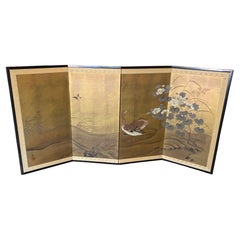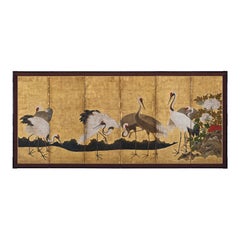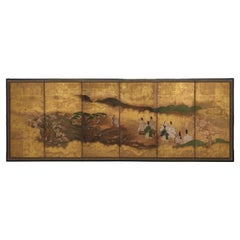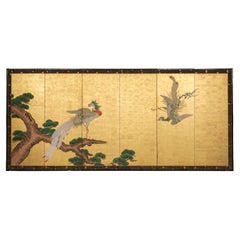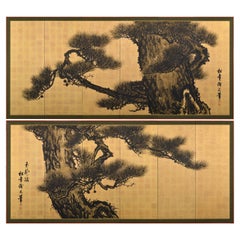Metal Paintings and Screens
to
57
285
101
448
40
2
19
11
2
1
74
167
207
42
58
31
11
13
1
1
4
2
3
6
1
773
767
725
539
490
427
407
321
82
33
490
461
473
10
2
2
2
2
Material: Metal
Japanese Asian Signed Four Panel Folding Byobu Screen Landscape Flowers & Geese
Located in Studio City, CA
A gorgeous four-panel Showa Period Japanese Byobu folding screen depicting a nature landscape scene with a two wild geese frolicking among the blossoming spring flowers as another co...
Category
20th Century Japanese Showa Metal Paintings and Screens
Materials
Gold Leaf
17th Century Japanese Screen. Cranes and Peonies. Edo period.
Located in Kyoto, JP
Cranes and Peonies
Anonymous, Kano School.
Edo period, second half of the 17th century.
Six-panel Japanese screen. Ink, pigment gofun and gold leaf on paper.
This Japanese screen...
Category
Mid-17th Century Japanese Edo Antique Metal Paintings and Screens
Materials
Gold Leaf
Mid-size 6-panel byôbu 屏風 with a scene from The Tale of Genji
Located in Amsterdam, NL
A refined medium-sized six-panel byôbu (folding screen) showcasing a classical autumn court scene from chapter 7 of The Tale of Genji (Genji Monogatari), titled Momiji no Ga (The Aut...
Category
17th Century Japanese Antique Metal Paintings and Screens
Materials
Metal, Gold Leaf
Tall 6-panel byôbu with phoenixes attributed to Kanô Isen’in Naganobu
By Kano Isen'in Naganobu
Located in Amsterdam, NL
An exquisite, tall six-panel byôbu (folding screen) featuring a painting attributed to Kanô Isen’in Naganobu (1775–1828) depicting a pair of phoenixes (hô’ô) and a section of a large...
Category
Early 19th Century Japanese Antique Metal Paintings and Screens
Materials
Metal, Gold Leaf
Circa 1900 Japanese Pine Screen Pair. Aged Dragons by Suzuki Shonen.
Located in Kyoto, JP
Suzuki Shonen (1848-1918)
Aged Dragons
A pair of six-panel Japanese screens. Ink and gold leaf on paper.
Dimensions: Each Screen: H. 170 cm x 378 cm (67" x 149")
As with the pair...
Category
Early 20th Century Japanese Meiji Metal Paintings and Screens
Materials
Gold Leaf
Early 20th Century Japanese Screen. Flowers of the Four Seasons.
Located in Kyoto, JP
Anonymous
Flowers of the Four Seasons
A four-panel Japanese screen. Ink, gofun and pigments on gold leaf.
This Japanese screen is a rich visual celebration of the flowers of the fo...
Category
Early 20th Century Japanese Taisho Metal Paintings and Screens
Materials
Gold Leaf
Japanese Asian Signed Four Panel Folding Byobu Screen Herons in the Winter Snow
Located in Studio City, CA
A gorgeous four-panel Showa Period Japanese Byobu folding screen depicting a nature landscape scene with a group of Herons frolicking in the snow covered bare Winter branches of a la...
Category
Mid-20th Century Japanese Showa Metal Paintings and Screens
Materials
Silver Leaf
Japanese Asian Signed Four-Panel Folding Byobu Showa Mountain Landscape Screen
Located in Studio City, CA
A gorgeous four-panel Japanese Byobu folding screen depicting a natural landscape scene with a small village and boats on the shimmering water. The dark, rich colors, gold leaf, and ...
Category
20th Century Japanese Showa Metal Paintings and Screens
Materials
Gold Leaf
Japanese Asian Signed Four-Panel Folding Byobu Showa Screen Tales of the Genji
Located in Studio City, CA
A gorgeous four-panel Japanese Byobu folding screen depicting a landscape scene from the classic Japanese narrative "Tales of the Genji" featuring Lady Murasaki the Japanese novelist...
Category
20th Century Japanese Showa Metal Paintings and Screens
Materials
Gold Leaf
18th Century Japanese Rinpa Screen. White Chrysanthemums. School of Korin.
Located in Kyoto, JP
School of Ogata Korin
White Chrysanthemums
18th Century, Edo period.
A two-panel Japanese screen. Ink, color, gofun and gold leaf on paper.
Dimensions: H. 171 cm x W. 188 cm (67.5” x 74”)
On this two-panel Japanese screen we see blooming chrysanthemums, a flower which embodies the essence of autumn in Japan. Here the traditional floral theme has been simplified and stylized. The bright colors and asymmetrical composition against the delicate gold leaf create a luxurious and ornate work of art. Its background, a strikingly patinated grid of gold leaf, denies any sense of place or time and imbues everything with an ethereal glow. The leaves and stems of the plants are nothing more than pools of mottled color and ink without any outline whatsoever. These are typical Rinpa adaptations of traditional ink painting methods; tarashikomi, or diluted washes of color blended while very wet, and mokkotsu, or “bonelessness,” which creates forms without exterior outlines. The relief work of the rounded flower petals has been obtained by the moriage process (a mixture based on ground shells modeled on the surface of the paper).
On the lower right of the screen, the siganture “Hokyo Korin Jakumyo” and the “Hoshuku” seal can be read. Korin is Ogata Korin, famed for the Irises (Nezu Museum) and Red and White Plum Blossom (MOA Museum of Art) folding screens, both National Treasures. Korin worked in both Kyoto and Edo in the mid-Edo period. Korin was using the art name “Jakumyo” just after he received the Hokyo level, which was in 1701.
This particular screen was published in May of 1961 in the Japanese Sansai Fine Art Magazine*. An in depth article accompanies the photograph of the screen and and a photograph of the signature and seal. This article devotes much of its body to discussing the moriage technique, how it enlivens the chrysanthemum flowers and Korin’s specific skill in using the technique. The article goes on to discuss the most famous works of Korin, utilizing this technique, which were known at the time. Specifically a two-panel screen held in the Honolulu Museum which was discovered in the store-house of Takahashi Soan. A two-panel screen pair which the Nakano family own. A two-panel screen pair with chrysanthemums in moriage in fan designs owned by the Nomura family. Also a small folding screen featuring chrysanthemums held in the Yamato Bunkakan. The article goes on to say that this particular two-fold screen came from the Nijo family. Korin is known to have had a strong connection with the aristocratic Nijo family. The article explains that Korin received a lot of favors from the Nijo family and that this screen would have been gifted to them.
Since that time the Honolulu screen has been amended to ‘attributed to Ogata Korin’ and I do not know further details of the other 3 screens. Other Chrysanthemum screens...
Category
18th Century Japanese Edo Antique Metal Paintings and Screens
Materials
Gold Leaf
Pair of Red and White Plum Blossom Screens After Ogata Korin
Located in Rio Vista, CA
Amazing pair of 18th century Edo period style paintings of red and white plum blossoms after Ogata Korin (Japanese 1658-1716). One of the most famous paintings in Japan where it is r...
Category
20th Century Japanese Edo Metal Paintings and Screens
Materials
Brass, Gold Leaf
Chinese Export Six Panel Coromandel Screen Gilt Courtyard
Located in Rio Vista, CA
Exceptional 20th century Chinese export six panel coromandel screen featuring a busy idyllic courtyard scene with a dramatic gilt background. The screen has six panels lacquered and ...
Category
20th Century Chinese Chinese Export Metal Paintings and Screens
Materials
Brass
Japanese Edo Screen Kano School Isle of Immortals
Located in Rio Vista, CA
Fascinating 19th century Japanese Edo period six-panel byobu screen depicting the Isle of Immortals. The painting features white Manchurian cranes among pines and flowering plum cent...
Category
19th Century Japanese Edo Antique Metal Paintings and Screens
Materials
Brass, Gold Leaf
Chinese Export Six Panel Coromandel Screen Gilt Courtyard
Located in Rio Vista, CA
Stunning 20th century Chinese export lacquered six-panel coromandel screen depicting a lush courtyard over a dramatic gold leaf ground. The lacquered panels are incised and painted w...
Category
20th Century Chinese Chinese Export Metal Paintings and Screens
Materials
Brass
Edo period Japanese Screen. Tiger and Pine by Kishi Ganku.
Located in Kyoto, JP
Kishi Ganku (1749/1756-1838)
Tiger and Pine
A six-panel Japanese Screen. Ink on silver leaf.
The central focus of this Japanese screen is a large tiger, emerging from shadow, crou...
Category
Late 18th Century Japanese Edo Antique Metal Paintings and Screens
Materials
Silver Leaf
Early 20th Century Japanese Inspired Screen Black Silk With Gold Embroidery
Located in Rümmingen, BW
This beautifully crafted folding screen (paravan) with a classic and elegant design, featuring three panels connected by hinges.
The dark almost black fabric is decorated with intri...
Category
Early 20th Century Chinoiserie Metal Paintings and Screens
Materials
Brass
Early 20th Century Japanese Cherry Blossom Screen by Kano Sanrakuki
Located in Kyoto, JP
Cherry Blossoms
Kano Sanrakuki (1898-1981)
Showa period, circa 1930
2-panel Japanese Screen
Color, gofun and gold leaf on paper
Against a backdrop of gold-leafed ground, the lichen covered trunk and branches of the life-sized cherry blossom tree reach out and beyond the confines of the pictorial surface. The overall composition has a feeling of flatness which draws emphasis to the surface and the three-dimensionality of the cherry blossoms. Painstakingly built-up layers of thickly applied shell-white gofun detail the voluminous blossoms and cover large areas of this tour-de-force of Japanese Nihonga painting. By simplifying the background, minimizing the number of colors and depicting the blossoms with such heavy relief, the artist has emphasized the stunning presence of the cherry tree. The type of tree depicted is the Yae-Zakura; a double-layered type of cherry blossom famed for its beauty and strength. When we think of Japanese cherry blossoms, the first thing that comes to mind is Somei Yoshino variety, which has a single flower with five almost white petals. This type is fragile and easily blown away by strong wind or rain. Most of the double-flowered cherry blossoms begin to bloom when the Somei-Yoshino falls, and the flowering period lasts longer than that of the Somei-Yoshino.
Kano Sanrakuki originally studied painting at the Kyoto City Arts and Crafts School under the tutelage of Yamamoto Shunkyo...
Category
Early 20th Century Japanese Showa Metal Paintings and Screens
Materials
Gold Leaf
Mid 18th Century Japanese Screen Pair. Crows & Pines by Unkoku Toshuku.
Located in Kyoto, JP
Unkoku Toshuku (1722-1779)
Crows and Pines
A pair of six-panel Japanese Screens. Ink and gold leaf on paper.
Dimensions: Each Screen: H. 170.5 cm x W. 375 cm
Haha-cho or mynah birds, whose forms resemble crows in artwork, were commonly depicted in Japanese art. These types of paintings were originally modeled on paintings attributed to the 13th century Chinese painter Muqi (Mokkei), whose art was enormously influential in Japan. Crows only became a theme among Japanese artists from the later 1500s onward. They likely were inspired by these imported Chinese paintings of myna birds, which are not native to Japan, substituting the native species of crow instead.
The best known early examples of the depiction of Japanese crows are two Momoyama screen...
Category
Mid-18th Century Japanese Edo Antique Metal Paintings and Screens
Materials
Gold Leaf
Early 19th Century Japanese Screen. Cherry Blossom & Pheasants by Mori Tetsuzan
Located in Kyoto, JP
Mori Tetsuzan (1775-1841)
Pheasants and Cherry Blossoms
Two-fold Japanese screen. Ink, color, gofun, gold and silver on paper.
A two-fold Japanese bir...
Category
Early 19th Century Japanese Edo Antique Metal Paintings and Screens
Materials
Gold Leaf
Gilded Chinese Six Panel Screen or Room Divider with Floral and Aviary Motifs
Located in Chicago, IL
A beautiful six panel gilded Chinese screen (or room divider) that had brass details at the feet.
The screen is painted both sides. The gilded side is elaborately decorated. It fe...
Category
1970s Chinese Chinese Export Vintage Metal Paintings and Screens
Materials
Brass, Gold Leaf
Japanese Antique Hand Painted Lotus And Blue Waters Screen Vibrant Colors
Located in South Burlington, VT
From our recent Japanese Acquisitions- Hard to Find Lotus Flowers
A stunning Japanese Antique Hand Painted six panel byobu screen on silk executed with lovely lotus flowers and vib...
Category
19th Century Japanese Meiji Antique Metal Paintings and Screens
Materials
Gold Leaf
$1,320 Sale Price
20% Off
Japanese Edo Two Panel Screen Meandering Stream with Birds
Located in Rio Vista, CA
Weathered Japanese late 18th century Edo period two-panel byobu screen depicting a meandering stream with sparrows in flight. Crafted with natural ink and color pigments on mulberry ...
Category
18th Century Japanese Edo Antique Metal Paintings and Screens
Materials
Brass
Circa 1700 Japanese Screen Pair, Cranes & Pines, Kyoto Kano School
Located in Kyoto, JP
Pines and Cranes
Anonymous. Kyoto Kano School.
Late 17th/early 18th centuries, circa 1700.
Pair of six-panel Japanese folding screens.
Ink, gofun, pigment and gold leaf on paper.
This bold composition presents two pine trees extending to the left and right across a gold leaf background. One tree is silhouetted against a green ground, golden clouds obscuring its true size, the other stretches across a stylized waterway. The pines are paired with Manchurian cranes with red crests and snow white plumage. Both have been highly auspicious motifs in East Asia since Chinese antiquity. Here the artist utilized fluid and instinctive ink brushstrokes to define the trunk, branches and tail feathers, in strong contrast to the precision and sharp angularity of the crane’s legs and beaks. The adoption of this vast metallic painting support required an unerring sense of design and composition, so that the negative space surrounding motifs could imply context for the otherwise floating pictorial elements. The brushwork detailing the trunks of the pines, the exaggerated dimensions of the pine trees and the strength and dynamism of the composition are all reminiscent of Kano Eitoku...
Category
Late 17th Century Japanese Edo Antique Metal Paintings and Screens
Materials
Gold Leaf
Chinoiserie Panel Hand Painted Wallpaper on Gold Metallic, Accept Custom Size
Located in Wuxi, 32
If you love the look of De Gournay wallpaper but not the price, this is for you.
The colorways in this sections present our latest colorways, which can be applied to any designs a...
Category
21st Century and Contemporary Chinese Metal Paintings and Screens
Materials
Gold Leaf
19th Century Japanese Screen, Deer in Spring, Maruyama Shijo School
Located in Kyoto, JP
A six-panel Japanese folding screen from the leading Maruyama-Shijo artist Okamoto Toyohiko (1773-1845). Simply featuring three deer and a few sprigs of foliage on a sumptuous gold-leaf background this work emphasizes naturalistic expression and a masterful use of negative space. Reduced to its most basic elements, the blank spaces inspire imagination and evoke the smells, sounds and even the weather of the scene. Whilst deer are traditionally depicted in association with autumn, here the green growth on the tops of the foliage indicates the season of spring. The work references Maruyama Okyo’s two-panel deer screen...
Category
Early 19th Century Japanese Edo Antique Metal Paintings and Screens
Materials
Gold Leaf
Chinoiserie Panel Hand Painted Wallpaper on Gold Metallic, Accept Custom Size
Located in Wuxi, 32
If you love the look of De Gournay wallpaper but not the price, this is for you.
The colorways in this sections present our latest colorways, which can be applied to any designs and...
Category
21st Century and Contemporary Chinese Metal Paintings and Screens
Materials
Gold Leaf
Kiku to Hagi Byobu, Rinpa School Style, Edo Period.
Located in Point Richmond, CA
A Chrysanthemum and Bush Clover painting on gold leaf six-panel folding screen, painted with clusters of leafy green chrysanthemum plants with white blossoms having moriage relief petals of gofun growing amidst pink blossoming bush clover within a bunched bush clover garden fence rendered in lighter gold relief, all on a background entirely of rich gold leaf. These two flowers are symbolic of Japan and the autumn season. The classic patterned paper verso with a Naga Antiques...
Category
Early 1800s Japanese Edo Antique Metal Paintings and Screens
Materials
Gold Leaf
Grand Chinese Export Eight Panel Lacquered Coromandel Screen
Located in Rio Vista, CA
Gorgeous Chinese export eight panel coromandel double sided screen depicting Han Palace on the front side. The screen features heavily lacquered panels incised with color pigments an...
Category
20th Century Chinese Chinese Export Metal Paintings and Screens
Materials
Brass
Chinoiser roll Hand Painted Wallpaper on Gold Metallic, Accept Custom Size
Located in Wuxi, 32
If you love the look of De Gournay wallpaper but not the price, this is for you.
The colorways in this sections present our latest colorways, which can be applied to any designs a...
Category
21st Century and Contemporary Chinese Metal Paintings and Screens
Materials
Gold Leaf
Large Japanese 2-Panel Byôbu 屏風 'Room Divider' with Painting of Bamboo & a Poem
Located in Amsterdam, NL
Beautiful, large two-panel byôbu (room divider) with a serene painting of red-leaved bamboo and rocks on an oxidized silver leaf background. Silver leaf continuously undergoes the process of oxidation, which creates a beautiful aged patina.
On the left an inscription from a ‘Zekku’ poem by the Chinese poet Yang Zai (1271?1323), titled: Shan shang zhu (bamboo (painted) on a fan).
Translated as :
Why would people plant a lot of bamboos?
The shade of a single culm is also beautiful.
In the autumn night it rocks on the wind,
And the fresh sound echoes in my dream.
Dated: Shôwa, the year kôshin (1938). Signature unknown...
Category
Early 20th Century Japanese Metal Paintings and Screens
Materials
Other, Silver Leaf
Stunning Set of Four 19th Century Edo Period Fusuma Door Decorative Panels
Located in Los Angeles, CA
A set of four fusuma (sliding door) panels from the 19th century, painted in ink and colors on gold leaf. The panels depict a blossoming cherry tree extending beyond a woven fence an...
Category
Late 19th Century Japanese Edo Antique Metal Paintings and Screens
Materials
Gold Leaf, Brass
Japanese Asian Signed Four-Panel Folding Byobu Showa Screen Tales of the Genji
Located in Studio City, CA
A gorgeous four-panel Japanese Byobu folding screen depicting a scene from the Classic Japanese narrative "Tales of the Genji". The vibrant, rich colors, gold leaf, and beautiful han...
Category
20th Century Japanese Showa Metal Paintings and Screens
Materials
Gold Leaf
Chinoiser Panel Hand Painted Wallpaper on Silver Metallic /Panel
Located in Wuxi, 32
If you love the look of De Gournay wallpaper but not the price, this is for you. Measures: 36" x 60".
The colorways in this sections present our latest colorways, which can be app...
Category
21st Century and Contemporary Chinese Metal Paintings and Screens
Materials
Silver Leaf
Chinese Six-Panel Carved Hardstone Lacquered Coromandel Screen
Located in Rio Vista, CA
Magnificent Chinese export six panel folding coromandel screen featuring hand-carved soapstone and hardstone decoration. The lacquered panels have recessed windows showcasing hand-ca...
Category
20th Century Chinese Chinese Export Metal Paintings and Screens
Materials
Soapstone, Brass
Japanese Showa Four Panel Screen Prunus with Songbirds
Located in Rio Vista, CA
Spectacular late 20th century Japanese Showa period four panel byobu screen depicting blossoming spring prunus or plum trees with songbirds in flight. The screen features a dramatic ...
Category
20th Century Japanese Showa Metal Paintings and Screens
Materials
Brass
Asian Polychrome Coromandel Black Lacquer Enamel Eight-Panel Court Floor Screen
Located in Germantown, MD
Chinese Polychrome Coromandel Black Lacquer Eight-Panel Court Screen. Comprised of 8 lacquered coromandel panels, this Chinese folding screen is intri...
Category
Late 20th Century Chinese Chinoiserie Metal Paintings and Screens
Materials
Enamel
$5,530 Sale Price
30% Off
Panoramic Mural Hand Painted Wallpaper on Gold Metallic, Accept Custom Size
Located in Wuxi, 32
If you love the look of De Gournay wallpaper but not the price, this is for you.
The colorways in this sections present our latest colorways, which can be applied to any designs a...
Category
21st Century and Contemporary Chinese Metal Paintings and Screens
Materials
Gold Leaf
Japanese Chinese Asian Large Six-Panel Folding Byobu Screen Mythical Landscape
Located in Studio City, CA
A gorgeous, strangely beautiful, unusually engaging, and alluring hand-painted large six-panel Japanese/Asian Byobu folding screen depicting an almost magical/ mythical nature scene ...
Category
18th Century Japanese Edo Antique Metal Paintings and Screens
Materials
Gold Leaf
Chinese Export Eight-Panel Lacquered Coromandel Screen
Located in Tarry Town, NY
Beautifully hand painted and decorated grand scale Chinese export Eight-panel Coromandel screen featuring different hand painted Chinese scene on each side. One side depicting an hand painted and parcel gilded court scenes. The reverse features a Chinese landscape scene. The screen measures 96 inches...
Category
Mid-20th Century Chinese Chinese Export Metal Paintings and Screens
Materials
Brass
Mid-18th Century Japanese Screen Pair, One Hundred Flowers, Chrysanthemums
Located in Kyoto, JP
Omori Soun (b. 1704)
Chrysanthemums - One Hundred Flowers
A Pair of Six-fold Japanese Screens. Ink, color, gofun and gold leaf on paper.
Dating ...
Category
Mid-18th Century Japanese Edo Antique Metal Paintings and Screens
Materials
Gold Leaf
Chinese Export Four Panel Carved Soapstone Coromandel Screen
Located in Rio Vista, CA
Charming Chinese export four panel coromandel screen featuring carved soapstone decoration. The panels are crafted from lacquered wood expertly fitted into frames with mortise and te...
Category
20th Century Chinese Chinese Export Metal Paintings and Screens
Materials
Soapstone, Brass
Exceptional Early 20C Korean 8 Panel Hand-painted Silk Screen/Divider
Located in Dallas, TX
PRESENTING A STUNNING and EXTREMELY RARE and DESIRABLE Early 20C Korean 8 Panel Hand-painted Silk Screen or Divider.
This screen consists of ...
Category
Early 20th Century Korean Country Metal Paintings and Screens
Materials
Brass
Japanese Showa Four Panel Screen Flower Vases on Silk
Located in Rio Vista, CA
Charming Japanese four-panel Showa period byobu screen depicting colorful floral arrangements in various vases and baskets. The hand-painted screen features vibrant natural color pig...
Category
20th Century Japanese Showa Metal Paintings and Screens
Materials
Brass
Early 20th Century Japanese Screen Pair - Ink Pine Trees on Gold
Located in Kyoto, JP
Imao Keisho (1902-1993)
Pine Trees
Early 20th Century, Circa 1930
Pair of six-panel Japanese screens. Ink on silk and gold leaf.
Dimensions: Each screen H. 67.5” x 148” (172 cm x 376 cm)
A pair of monumental six-panel Japanese pine screens by the renowned Nihonga artist Imao Keisho. Here Keisho entirely removed the background and brought the pine trees to the surface of the painting. This simplification of the elements makes the scene exceptionally direct and compelling and injects a very modern...
Category
Early 20th Century Japanese Showa Metal Paintings and Screens
Materials
Gold Leaf
Japanese antique screen - EDO period - Willow over a stream
Located in Prahran, Victoria
Antique Japanese 6 panel screen from the early Edo period (C1650). One of a pair (both available). This magnificent golden screen shows...
Category
1650s Japanese Edo Antique Metal Paintings and Screens
Materials
Gold Leaf
Chinese Export Eight Panel Coromandel Screen Pagoda Courtyard
Located in Rio Vista, CA
Fantastic large Chinese export eight-panel coromandel screen featuring a colorful pagoda courtyard with figures engaged in leisurely activities. The large screen measures 7 feet high...
Category
20th Century Chinese Chinese Export Metal Paintings and Screens
Materials
Brass
Byobu - Japanese Screen "Kano School" Gold Leaf
Located in Brescia, IT
Japanese Kano School Six Panel Screen: Landscape with Beautiful and Elegant Cranes near the River, with Pines and Sakura.
Hand painted with mineral pigments and inks on vegetable pap...
Category
Late 18th Century Japanese Edo Antique Metal Paintings and Screens
Materials
Gold Leaf
Japanese Meiji Four Panel Screen Wild Geese Over Reeds
Located in Rio Vista, CA
Muromachi period inspired Japanese four panel byobu screen depicting wild geese in flight over reeds. The 19th century Meiji period painting bears an artist's signature Chisokuken. C...
Category
19th Century Japanese Meiji Antique Metal Paintings and Screens
Materials
Brass
Chinese Export Four Panel Coromandel Screen Walled Pavilion
Located in Rio Vista, CA
Distinctive Chinese export four-panel coromandel screen depicting a walled pavilion with figures engaged in leisurely activities. The scene appears to be from the 18th century Qing d...
Category
20th Century Chinese Chinese Export Metal Paintings and Screens
Materials
Brass
circa 1930 Japanese Silver Screens by Isoi Joshin, Flowers of the Four Seasons
Located in Kyoto, JP
Flowers of the four seasons
Isoi Joshin (1883-1964)
Pair of six-panel Japanese screens
Ink, pigment, lacquer and silver leaf on pa...
Category
Mid-20th Century Asian Showa Metal Paintings and Screens
Materials
Silver Leaf
17th Century Japanese Screen Pair. Flock of Cranes. Ink and color on gold leaf.
Located in Kyoto, JP
A pair of six-fold Japanese screens from the 17th century depicting a flock of cranes arriving at their wintering grounds. The expansive scene is heavily atmospheric. The cranes are...
Category
17th Century Japanese Edo Antique Metal Paintings and Screens
Materials
Gold Leaf
18th Century Japanese Floral Paintings, Set of 5, Mineral Pigments on Gold Leaf
Located in Kyoto, JP
A set of 5 Japanese floral paintings from the 18th century. Each painted with mineral pigments directly applied to gold leaf. They were originally designed to be mounted on the leave...
Category
Mid-18th Century Japanese Edo Antique Metal Paintings and Screens
Materials
Gold Leaf
Late 17th Century Japanese Screen Pair. Battle of Ichi-no-tani and Yashima.
Located in Kyoto, JP
Anonymous
Late 17th Century
Battle of Ichi-no-tani & Yashima
Dimensions: Each Screen: H. 175 cm x W. 385 cm (69” x 151.5”)
This pair of Japanese screens depict two significant battles from the Genpei War (1180–85), as recounted in the Tale of the Heike, a semi-historical epic chronicling the conflict between rival clans for control of Japan, written in the early 1200s.
Each screen portrays a single battle through a series of small episodes, framed by gold clouds, landscape elements, and architectural features. True to the style of many screens inspired by The Tale of the Heike, the scenes are rendered in lavish colors and gold, downplaying the brutality of the warfare. Although based on real events, these narratives often glorified and romanticized the heroic feats of the warriors. Viewers at the time would have been familiar with the story’s details, leading to a proliferation of paintings on folding screens inspired by this theme from the late Muromachi to the early Edo periods.
On the right screen, we see the Minamoto’s attack on the Taira, who have retreated from the capital, Kyoto, toward the sea. The central building represents the temporary Taira headquarters, where Taira soldiers are holding the young Emperor Antoku. The Minamoto plan to launch a surprise attack from the rear after descending the steep cliff known as Ichi-no-tani, depicted at the top center. This scene highlights the tactical brilliance of Minamoto commander Yoshitsune and the courage of his men.
The left screen captures moments from the Battle of Yashima...
Category
Late 17th Century Japanese Edo Antique Metal Paintings and Screens
Materials
Gold Leaf
Chinese Export Eight Panel Coromandel Screen Lotus Blossoms
Located in Rio Vista, CA
Grand Chinese export post republic period eight panel coromandel screen featuring a waterscape decorated with blossoming lotus and birds....
Category
20th Century Chinese Chinese Export Metal Paintings and Screens
Materials
Brass
Chinese Export Four Panel Carved Soapstone Coromandel Screen
Located in Rio Vista, CA
Amazing Chinese export four panel coromandel screen featuring beauties in a pagoda pavilion landscape. Beautifully crafted from intricately carved soapstone in vivid colors and fasci...
Category
20th Century Chinese Chinese Export Metal Paintings and Screens
Materials
Soapstone, Brass
Chinese Kuancai Ten Panel Coromandel Screen Mythical Landscape
Located in Rio Vista, CA
Amazing Chinese export Kuancai ten-panel coromandel screen featuring a mythical flora and fauna landscape. Made in the 17th century style that was so loved and collected by Coco Chan...
Category
20th Century Chinese Chinese Export Metal Paintings and Screens
Materials
Brass
Japanese Kano School Four Panel Screen Birds and Owl
Located in Rio Vista, CA
Amazing 19th century Japanese Meiji period four-panel byobu screen featuring painted panels depicting egrets, heron, pheasants, songbirds, and an owl. Painted with ink and natural co...
Category
19th Century Japanese Meiji Antique Metal Paintings and Screens
Materials
Gold Leaf
Japanese Screen Pair, Tigers by Kishi Renzan, Late Edo Period
Located in Kyoto, JP
Kishi Renzan (1804-1859)
Tigers
Pair of six-panel Japanese screens.
Ink and gold-leaf on paper.
In this monochromatic pair of six-fold Japanese screens painted on gold-leaf, Kishi Renzan has created a breathtaking composition of a family of tigers. The screens are filled with a sense of drama which is conveyed by both the subject matter and the wet, expressive brushwork. The running mountain stream and the towering waterfall allude to refreshment during the summer months and we feel the tiger families familiarity and security within their environment. Renzan’s master, Kishi Ganku...
Category
Mid-19th Century Asian Edo Antique Metal Paintings and Screens
Materials
Gold Leaf
Chinese Export Lacquered Four Panel Coromandel Screen
Located in Rio Vista, CA
Beautifully weathered Chinese export four-panel coromandel screen decorated on both sides. The screen features a pavilion landscape on one side and a floral and fauna landscape on th...
Category
20th Century Chinese Chinese Export Metal Paintings and Screens
Materials
Brass
Chinese Export Four Panel Coromandel Screen Cranes on Gold Leaf
Located in Rio Vista, CA
Dazzling Chinese export lacquered four-panel coromandel screen featuring a flora and fauna waterscape with stylized cranes. The carved lacquer panels...
Category
20th Century Chinese Chinese Export Metal Paintings and Screens
Materials
Brass, Gold Leaf
Recently Viewed
View AllMore Ways To Browse
Japanese Red Lacquer Frame
Lattice Panel Wood
Hanging Japanese Screen
Japanese Lattice
Japanese 19th Century Meiji Period Silk Painting
Japanese Buddhist Screen
Japanese Carved Screen
Japanese Screens And Doors
Monkey Screen
Japanese Autumn Screen
Japanese Screens Six Fold
Japanese Wood Room Divider
Kyoto Silk Painting
Japanese Dragon Painting
Japanese Birds Painted On Silk
Heian Period
Japanese Crane Panel
Japanese Divider Screen
